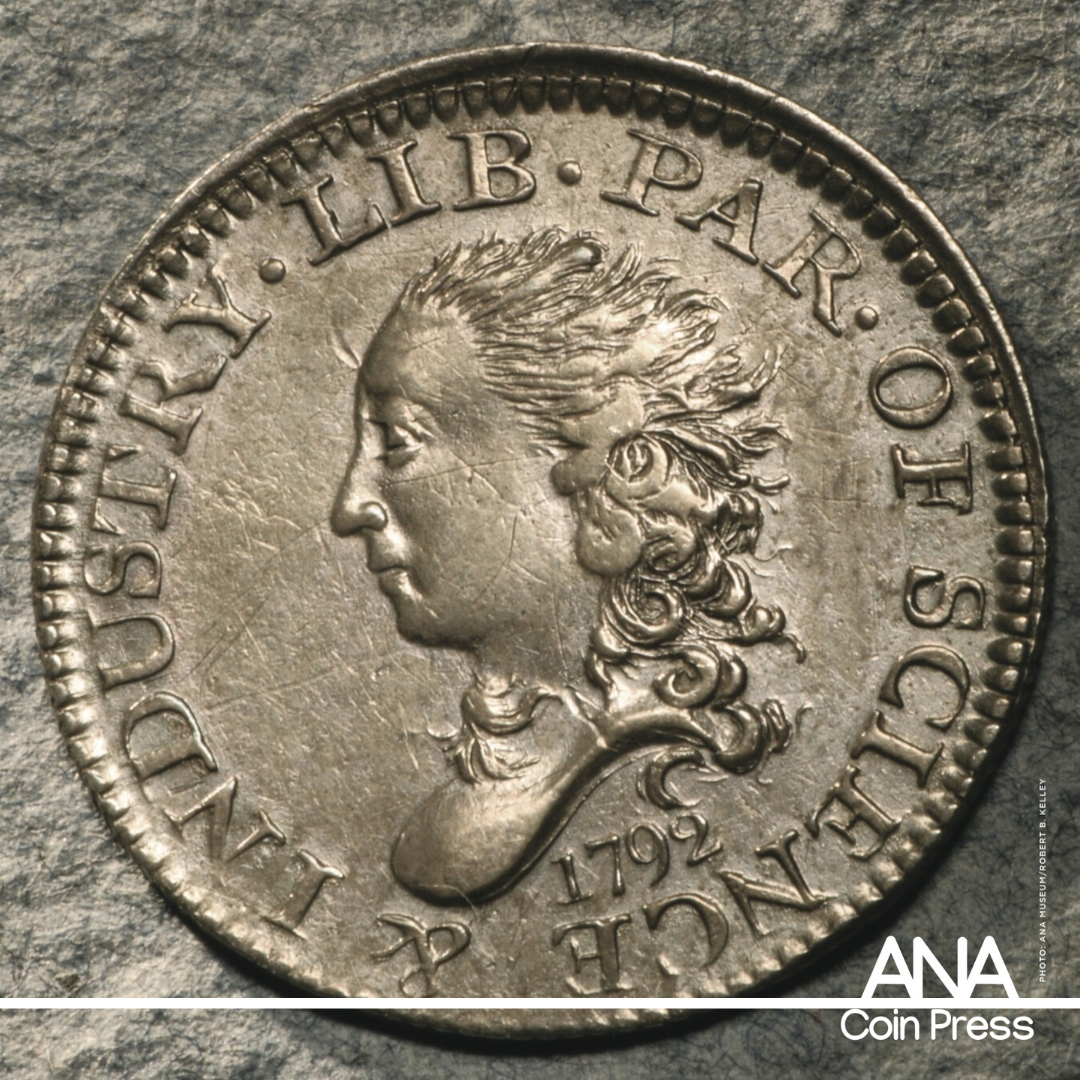A More Accurate History of the 1792 Half Disme
A tale of three sources, two strikes and one president.
The first 1,500 coins of the infant United States Mint came off the press in the late-18th century and almost immediately disappeared from view. Centuries after its modest debut, that revolutionary emission—the 1792 half disme—is shrouded in mystery: Was it struck at the Philadelphia Mint or in the cellar of a mint contractor? Was it produced in Summer 1792, prior to the mint’s opening, or in October of that year, after operations began? Were the half dismes meant to be patterns to secure design approval, or were they business strikes, intended for circulation? Who provided the bullion for their production, President George Washington or someone lesser known? If it was Washington, did he donate his personal silverware or silver bullion in some other form?
Two seemingly authoritative sources that surfaced during the mid-19th century provided answers to these questions. They corroborated some assertions and contradicted others. Inevitably, collectors, dealers and scholars chose sides and argued for 150 years about which source was more credible and which story was more plausible. Unbeknownst to these bickering numismatists, however, the definitive answers to these vexing questions were recorded by a third and very reliable source. Information from that reference dribbled out slowly between 1966 and 2003, and glimpses of the story emerged. However, it was not until we thoroughly examined this third source that a more accurate history of the half disme could, for the first time, be revealed. The “extended version” of that history, along with that of the other 1792-dated coins, appear in our book 1792: Birth of a Nation’s Coinage, published in 2017 by the Ivy Press, a subsidiary of Heritage Auctions.
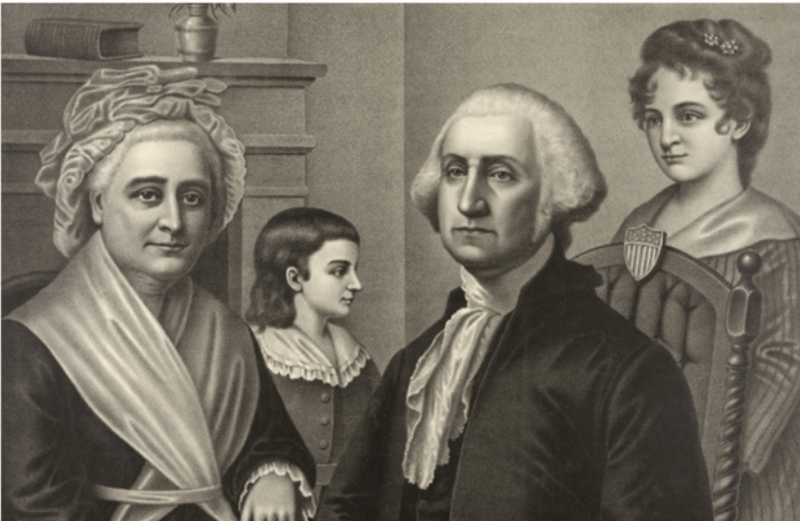
▲ FOR CENTURIES, scholars have debated whether George and Martha Washington donated the family silver for America's first coinage. Photo: Library of Congress
The story of the half disme begins with its obscure gestation, striking and distribution. When it was struck in 1792, hardly anyone took notice. No announcement was made, no “first strike” ceremony was recorded, and not a single newspaper in Philadelphia, or anywhere else, covered the story. Modest in appearance and comparatively few in number, the half dismes vanished from the scene just as quietly as they arrived.
Over the next 40 years, pioneering coin collectors encountered, every now and again, tiny silver U.S. 5-cent pieces that carried the peculiar word “disme.” They wondered about the whys and wherefores of these enigmatic coins, but in the early 1830s, numismatic knowledge was sparse. No books or magazines focused on American coins; no coin clubs existed; written records were scattered; and collectors toiled in isolation. An enterprising numismatist might have contacted mint personnel to seek information, but by the early 1830s, all of the men who had worked on the first federal coinage of 1792 were long since dead, leaving only the faintest of paper trails.
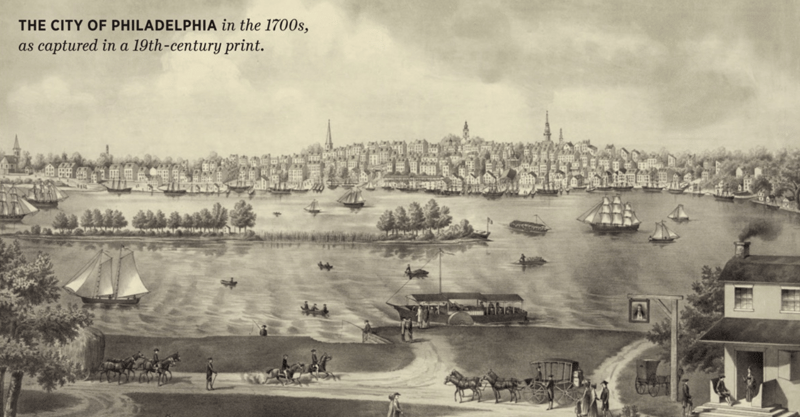
Photo: Library of Congress
The first collectors who added half dismes to their cabinets, therefore, could only admire them in wonderment. A few were more proactive. In 1838, for instance, William G. Stearns of Boston wrote to Mint Director Robert M. Patterson, asking for a detailed description of the all-but mythical 1792 half disme. Patterson obliged by sending basic information about the piece, but enclosed no illustration.
At the end of the 1830s, at long last, the flywheel of numismatic knowledge slowly started to turn. In 1839 the Reverend Joseph B. Felt wrote the first American book with significant numismatic content, An Historical Account of the Massachusetts Coinage. Three years later, U.S. Mint Assayers Jacob B. Eckfeldt and William E. Dubois produced A Manual of Gold and Silver Coins of All Nations, featuring engraved illustrations. Half dismes had disappeared from circulation by 1842, so the manual did not mention them. Dubois was back in print in 1846 with Pledges of History, a guide to the mint’s coin cabinet. He was the first author to mention the 1792 half disme, thus confirming its genuineness, but since the book was not illustrated, collectors still wondered what the piece looked like.
"When the half disme was struck in 1792, hardly anyone took notice. Not a single newspaper in Philadelphia covered the story."
Finally, in 1857, as coin collecting was experiencing a boom, Norton’s Literary Letter (a periodical for bibliophiles) published the first engraving of this petite 5-cent piece. And, 67 years after the half dismes were struck, Dr. Montroville Wilson Dickeson, the “Indiana Jones” of his day, wrote the first comprehensive guide to the hobby, The American Numismatical Manual. Quaint though Dickeson’s spelling might have been, his technology was fairly sophisticated, for his book included 19 plates of tinted facsimile illustrations, including a half disme. Collectors at last had basic information and images for reference.
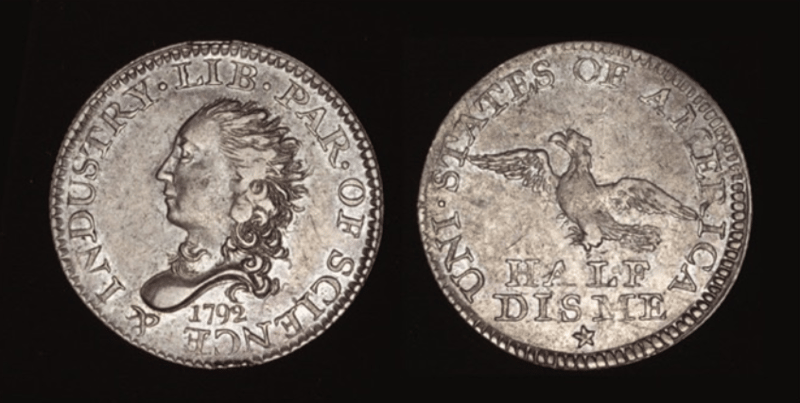
▲ WITHIN A FEW DECADES of its debut in 1792, the half disme had become almost mythical among numismatists. Photo: ANA Museum/Robert B. Kelley; Actual Size: 16.5mm
The first authoritative source about half dismes actually emerged before anything on the subject saw print. On April 9, 1844, two distinguished gentlemen entered the stately Greek Revival building that housed the second United States Mint in Philadelphia. Hosting the meeting was the mint’s Nestor, Adam Eckfeldt. Although he had retired as chief coiner five years previously, he still kept an office at the mint (and, according to Mint Melter and Refiner Richard McCulloh, Eckfeldt was still doing the work of chief coiner, leaving his nominal successor, Franklin Peale, free to strike medals for his own profit and to use mint workmen to make a whoopee-cushion sofa).
Eckfeldt’s guest that day in April was John McAllister Jr., a retired optician, avid local historian and enthusiastic hobbyist. He also was a collector and a scholar who gathered every scrap of numismatic information he could. (He had maintained a clipping file since 1826.) He intended to pump Eckfeldt for information on the 1792 half dismes.
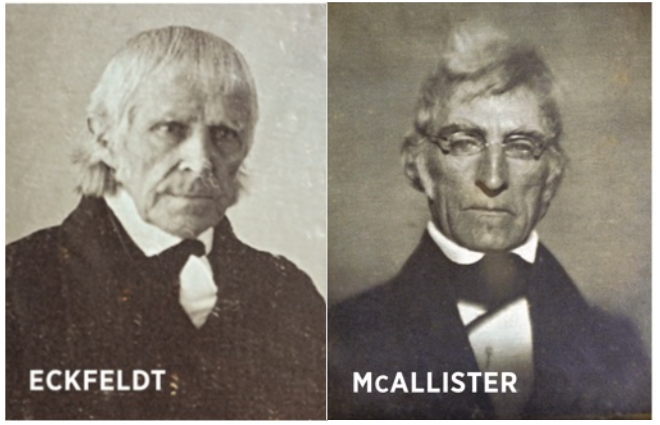
Photos: Library of Congress/Robert Cornelius (McAllister); & Eckfeldt Family Collection
Indeed, Adam Eckfeldt was the closest thing to an original mint employee. He had been a part-time contractor, providing blacksmithing services, during the facility’s inaugural year. The likelihood that he was actually present at the creation of the half dismes, therefore, is very small. On July 1, 1795, Eckfeldt became a full-time mint employee and reported directly to the man who almost undoubtedly oversaw the striking of the half dismes, Chief Coiner Henry Voigt. Eckfeldt also worked side-by side with Mint Director David Rittenhouse during the latter’s final year in the traces. Given Eckfeldt’s keen interest in the mint’s history, it seems likely he would have asked Voigt about the first three years of the institution’s operations at some point during the 19 years he reported to the first chief coiner. McAllister clearly hoped to get a near-eyewitness account of the half disme’s creation, although Eckfeldt was by then calling upon memories of 30- to 50-year-old conversations.
"Eckfeldt was the closest thing to an original mint employee. He had been a part-time contractor, providing blacksmithing services."
McAllister returned home after the meeting and wrote a memorandum that summarized his interview with Eckfeldt. The retired chief coiner made six claims:
- The half dismes were struck expressly for President George Washington.
- Washington himself provided the silver for their striking in the form of bullion or coin.
- Washington’s silver was valued at $100.
- Washington received full value in return, getting $100 worth of half dismes (2,000 total).
- The half dismes were never intended for circulation and instead were distributed by Washington to his friends as souvenirs.
- The half dismes were created before the mint was ready for operation and were struck in the cellar of a mint contractor, saw-maker John Harper. His establishment was at the northeast corner of the intersection of North Sixth and Cherry Streets, just one block east and a block north of the mint’s site on North Seventh Street.
McAllister took pains to record the interview accurately, for he penned two drafts of his memorandum, both signed with his initials, before writing the final version, which he carefully signed using his full name. Although none of these three versions were published until 1943, nearly a century after his meeting at the mint, all six claims noted in the memorandum were closely quoted by a variety of publications starting in the early 1850s. Among these were the Philadelphia Dispatch newspaper in 1853; Norton’s Literary Letter in 1857; Richard Hickox’s Historical Account of American Coinage in 1858; and Dickeson’s American Numismatical Manual in 1859. Since Eckfeldt’s claims were printed virtually verbatim, at least one copy of the memorandum must have been available to researchers and writers. As early as 1855, thanks to Adam Eckfeldt and his chronicler, John McAllister Jr., coin sale catalogers were calling the 5-cent pieces of 1792 “Washington half dismes.”
McAllister’s memo “went public” with exquisite timing, for the late 1850s witnessed an unprecedented popular enthusiasm for numismatics that rapidly developed into a full-fledged mania. The immediate reason for this was the replacement of the large cent by the small Flying Eagle cent in 1857. People eagerly began to search their pocket change for the oversized copper relics of their youth, and a modest hobby became a nationwide pastime almost overnight.
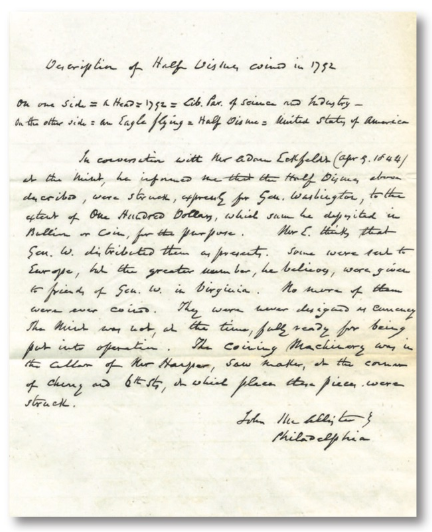
▲ THE MCALLISTER MEMORANDUM (shown here in its third and final version) made six claims regarding the 1792 half disme. Photo: Joel J. Orosz
At the same time, the Union was disintegrating into sections north and south. Southern “fire-eaters'' and their northern “dough-face” allies squared off against northern abolitionists and anti-expansionists. Historical heroes were posthumously assigned to one camp or the other; Benjamin Franklin, for instance, was celebrated as a proto-abolitionist, and Andrew Jackson was cited as a champion of slavery. Only one pillar of American history remained sacred to both sides: George Washington, the Virginia planter to the south, the Federalist emancipator to the north, and to both, the man who had won their freedom. The claims of McAllister’s memorandum added even more luster to Washington’s illustrious name, enveloping the diminutive half dismes in the soft aura of hero worship. Struck for Washington, with silver provided by the general! Given as gifts to friends by the president himself!
In 1860 and again in 1861, as tensions built toward the crescendo of civil war, a second authoritative source—U.S. Mint Director James Ross Snowden, no less—twice recounted the story of Washington and the half dismes. In his two books—A Description of the Ancient and Modern Coins in the Cabinet Collection of the Mint of the United States (1860) and A Description of the Medals of Washington (1861)—Snowden presented some valuable new information but also contradicted some of what Eckfeldt had related through McAllister. Bewilderingly, Snowden’s books also contradicted each other, leaving collectors confused and scholars squabbling for more than a century.
"McAllister took pains to accurately record the interview, for he penned two drafts, both signed with his initials."
Little did Snowden foresee this when his first tome was released. He began his discussion of half dismes by agreeing with McAllister’s first and second claims that these coins were struck expressly for Washington with silver the president provided, although Snowden couldn’t resist embellishing the story. In his telling, the memorandum’s “bullion or coin” became Washington’s “private plate”; in other words, the president’s own silver table service. Snowden also implicitly agreed with claims three and four—the value of $100 for the silver plate, and the mintage of 2,000 half dismes.
When it came to the memorandum’s assertion that the half dismes were not intended for circulation, Snowden was highly ambivalent. He wrote that Washington, judging from what he said about half dismes in his fourth annual address to Congress on November 6, 1792, evidently  considered them to be circulating coins. However, that fact notwithstanding, he felt they still should be classified as patterns. Finally, Snowden firmly contradicted the memorandum’s claim that the half dismes were struck in John Harper’s cellar, before the mint was operational, and he had solid evidence. Quoting from the mint’s first account book (presumably recorded by Chief Coiner Henry Voigt), Director Snowden maintained the half dismes were struck at the mint in early October 1792. Voigt almost undoubtedly oversaw Harper’s striking of the half dismes, so he clearly would have known when it happened. ►JAMES ROSS SNOWDEN, depicted here on a U.S. Mint medal, had his own ideas regarding the origin and intent of the half dismes. Not Actual Size.
considered them to be circulating coins. However, that fact notwithstanding, he felt they still should be classified as patterns. Finally, Snowden firmly contradicted the memorandum’s claim that the half dismes were struck in John Harper’s cellar, before the mint was operational, and he had solid evidence. Quoting from the mint’s first account book (presumably recorded by Chief Coiner Henry Voigt), Director Snowden maintained the half dismes were struck at the mint in early October 1792. Voigt almost undoubtedly oversaw Harper’s striking of the half dismes, so he clearly would have known when it happened. ►JAMES ROSS SNOWDEN, depicted here on a U.S. Mint medal, had his own ideas regarding the origin and intent of the half dismes. Not Actual Size.
In 1861, just as Southern states were seceding from the Union, James Ross Snowden released his second book. In it, he revisited the story of the half dismes, but instead of clarifying the waters he had muddied the year before, he stirred up more sediment. As he had done in his earlier book, he began by agreeing with the first four claims set forth in McAllister’s memorandum. He then proceeded to disagree decisively with McAllister’s fifth claim and completely contradict himself with regard to claim six!
The year prior, Snowden had been ambivalent about whether half dismes were regular issues or patterns. Now, in 1861, he classified them as business strikes. That shift, however, was minor compared to a complete change of heart regarding the time and place of striking. In A Description of Ancient and Modern Coins, he quoted Voigt’s first account book, saying that the coins were made at the mint in early October 1792. But in A Description of the Medals of Washington, he abandoned Voigt’s evidence, and embraced Eckfeldt’s claim that the striking occurred before the mint was ready for production.
An African proverb holds that “when elephants fight, it is the grass that suffers.” When Snowden and Voigt clashed with McAllister and Eckfeldt about the coinage status of the half dismes and the time and place of their striking, it was the coin collectors and numismatic scholars who suffered. For more than a century, they traded potshots on these points and on the source of the coinage metal. Their arguments were litigated in scores of books, articles and catalog descriptions, and while the preponderance of opinion leaned toward pattern status, Harper’s production in September, and Washington’s table service, there were always enough dissenters to prevent the questions from being completely settled.
"Jefferson left Philadelphia with 1,500 coins capable of making change in ways that were entirely novel to the young United States."
Then, in 1966, a third authoritative source burst upon the scene, boasting more bona fides than Eckfeldt and Snowden combined. The latter gentlemen had approached the question ex post facto, relying on other people’s testimonies. Not so Thomas Jefferson, who participated firsthand and recorded the events as they occurred. In 1792 Jefferson was in charge of organizing the mint and was the man to whom Director David Rittenhouse and (indirectly) Chief Coiner Henry Voigt reported. Jefferson experienced what Eckfeldt and Snowden could only read about: the actual process that led to the half dismes. He figuratively was, in the words from the musical Hamilton, “in the room where it happened.”
Yet, if Jefferson was so central to the history of the half dismes, why did it take 174 years to find the evidence he left behind? There are two reasons. First, Jefferson’s records of the half disme were kept in an unexpected place: not in a government archive or official publication, but rather in one of his private memorandum books, in which he tracked his personal income and expenditures. Second, his memorandum book for 1792 was not published until 1997 in The Papers of Thomas Jefferson (second series), so the pertinent entries about the half dismes were effectively hidden from researchers. Credit for discovering the numismatic significance of Jefferson’s 1792 memorandum book goes to Don Taxay, who found it in the collection of the New York Public Library in the course of researching his 1966 book, The United States Mint and Coinage.
Jefferson’s memorandum book, however, revealed the full extent of its information reluctantly. Taxay discovered and quoted only one of two passages in which half dismes were directly mentioned. It was not until 37 years after Taxay published one entry that researchers Joel J. Orosz and Carl Herkowitz discovered and published the other. Another 14 years would pass before the authors of this article recognized and published a number of passages that, while they do not explicitly mention half dismes, still have direct bearing on their story. It was then that Jefferson’s 1792 memorandum book surrendered all its secrets and made possible a much fuller history of the half dismes. This information contradicted most of Eckfeldt’s claims and provided a surprising measure of vindication for Snowden.
Among Thomas Jefferson’s memoranda was an entry for Tuesday, July 10, 1792, noting that he withdrew “100. D.” from the Bank of the United States, probably in the form of Spanish silver dollars. The next day (in the entry discovered by Orosz and Herkowitz), he “Delivd. 75. D. at the mint to be coined.” Then, on Friday, July 13, 1792 ( in the passage discovered by Taxay), Jefferson “Recd. from the mint 1500. half dismes of the new coinage.”
Jefferson knew that Section 14 of the April 2, 1792, Mint Act provided that any citizen could bring bullion to the mint and have it struck— weight-for-weight—into silver or gold coins. In other words, any citizen presenting $75 worth of silver bullion or coin to the mint was entitled to receive $75 in new silver coinage of the United States. The memorandum book provides solid evidence that Citizen Jefferson did just that on July 11-13, 1792.
These two passages knock the props from under four of the six claims in the McAllister memorandum that Snowden supported. It is clear that the half dismes were not struck expressly for President Washington, nor did he provide the silver to strike them. The silver did not amount to $100 in value, nor did Washington receive $100 in half dismes from the mint. It is clear, however, that all four of these claims were true of Jefferson, excepting that the amount of silver deposited and collected as half dismes amounted not to $100, but rather to $75.
.jpg?width=800&name=thomas%20jefferson%20(1).jpg)
▲ THOMAS JEFFERSON meticulously tracked his expenses in a memorandum book that firmly establishes his starring role in the creation of the 1792 half dismes. Painting: Independence National Historical Park/Charles Willson Peale
And what of the two remaining claims? Again, the 1792 memorandum book provides the answers. Immediately after Jefferson took delivery of the 1,500 half dismes on Friday, July 13, 1792, he left Philadelphia with his daughter Maria to spend the summer at Monticello, his estate near Charlottesville, Virginia. Prior to that date, Jefferson’s memorandum book entries were reckoned primarily in Spanish dollars and fractional bits thereof, with each bit worth 12.5 cents, and secondarily in the Anglo-American system of pounds, shillings and pence. For instance, on June 15, 1792, Jefferson paid $2.25—two Spanish dollars and two bits—to “Miss Gilmore” for services rendered to Maria. On June 22, 1792, he paid a grocery bill of £7-7-4. There are no records in the memorandum book prior to July 13, 1792, for transactions in the amount of 5 cents or small multiples thereof—10, 15, 20, 30, 35, 40 or 45 cents—since no coin or common combination of coins in either the Spanish or the Anglo-American systems equated to these precise numbers.
Jefferson, therefore, left Philadelphia on the afternoon of Friday, July 13, 1792, with 1,500 half dismes representing a new decimalized federal coinage capable of making change in ways that were entirely novel to the young United States. That evening, Jefferson and Maria lodged in Chester, Pennsylvania, about 18 miles from Philadelphia. In his final memorandum book entry under that date, Jefferson recorded tipping “servants” in the amount of 30 cents, which could only have signified the expenditure of six half dismes. Interestingly, the individuals on the receiving end of this first transaction using federal money were almost certainly African Americans—freed blacks, or slaves living temporarily in Pennsylvania.
"The evidence is compelling, making the business-strike conclusion all but inescapable."
The memorandum book reveals many expenditures of 5 to 35 cents during the rest of Jefferson’s trip to Monticello; his summer sojourn there; and his return journey to Philadelphia. After October 5, 1792, back in the temporary capital, the Secretary of State’s expenditures in the amount of 5 cents or small multiples ceased. His memorandum book entries reverted to use of Spanish dollars and bits, or Anglo-American pounds, shillings and pence. These entries indirectly, but persuasively, indicate that he spent all the 1,500 half dismes he had received in July by the end of his vacation in October. It also puts a torpedo amidships of the fifth memorandum claim that half dismes were struck as patterns. There is no evidence whatsoever that any half dismes ever were sent to officials of any branch of the government for consideration as regular-issue coinage. The evidence is compelling—Jefferson freely spent all 1,500 half dimes, making the business-strike designation all but inescapable.
Ultimately , Jefferson’s memorandum book confirms only McAllister’s sixth claim. The Philadelphia Mint indeed was not in operation on July 11-13, 1792. In fact, President Washington had not approved the purchase of the property until July 9, and the razing of the structures thereon did not begin until July 19. While the memorandum book does not specifically name Harper’s cellar as the location of the striking, the half dismes had to be struck off the mint’s campus, and Harper—who had previous experience as a state coinage artisan, had coining equipment on his premises and had been a mint contractor in 1792—would have been a logical choice.
Jefferson’s memorandum book thus settles every major question surrounding the half dismes save one: what about Snowden’s quotation from Henry Voigt’s first account book stating that the half dismes were struck in early October 1792? And what about the more specific information found in John S. Dye’s Coin Encyclopedia, published in Philadelphia in 1883, which maintained that the half dismes were struck at the mint on October 9, 1792? The obvious step would be to verify this information in Voigt’s first account book—an impossibility since it has been missing from the mint’s archives since at least 1924.
Another way to settle this time-and-place question is to carefully examine the coins themselves. We did just that, conducting detailed census research on each of the specimens of 1792. An important outcome of the half disme census is the discovery of compelling evidence that both Jefferson and Voigt were correct: a first strike of the half dismes occurred on July 11-13, 1792, and a second strike took place, just as Voigt and Dye recorded, on October 9, 1792.
All the half dismes observed were struck from a single pair of dies and represent six different die states. The first four states gradually transition from one to the next as die cracks progressively expand. Between the fourth and the fifth die states, however, the transition is not smooth; instead, on the reverse there abruptly appears a sizable rough, raised patch, readily visible even on uncirculated pieces. Two explanations could account for this: the development of die rust in that area, or “spalling” (the loss of surface area due to underlying mechanical stress). Die rust occurs gradually, usually when dies are not in use, while spalling can occur suddenly.
Voigt’s first account book, as quoted by Snowden, indicated that the mint received three coining presses on September 21, 1792. All three had to be assembled, dressed and prepared for trial strikes—operations that were completed by October 9, when they were ready for testing. It is probable that the only dies on hand with which to make these trial strikes were those for the 1792 half disme, which had been in storage since July 13. At the beginning of the test strikes, either die rust had developed on the reverse, or the reverse had die spalled. Judging from the number of surviving half dismes in die states 5 and 6, about 200 to 500 additional examples were struck on October 9. Many of them were retained as souvenirs (both David Rittenhouse and Adam Eckfeldt possessed a dozen or fewer half dismes), and a disproportionately high number, in comparison to the first four die states, are uncirculated. Perhaps this is where Eckfeldt got the notion that the half dismes were patterns that were distributed as gifts.
Thus, it is clear that both Eckfeldt and Voigt were correct in their assertion that half dismes were struck once at Harper’s cellar on July 11-13, before the mint was ready for operation, and again on October 9, when the mint was up and running. Perhaps James Ross Snowden can be forgiven for his ambiguity about the timing of the strikes and the status of the coins produced.
It took 225 years to finally reveal a more accurate history of the 1792 half disme. We now can say with confidence that it was Thomas Jefferson (not George Washington) who provided the $75 in silver, probably in the form of coins and not a personal silver service. The first striking, in Harper’s cellar on July 11-13, 1792, yielded 1,500 (not 2,000) half dismes. They were delivered to Jefferson (not Washington), who spent them in Pennsylvania, Delaware, Maryland and Virginia from July 13 to October 5, 1792, and did not distribute them as presents. The second striking, at the mint’s new facility on North Seventh Street, occurred on October 9, 1792, yielding approximately 200 to 500 half dismes, significant numbers of which were retained as souvenirs by David Rittenhouse and others. Some of the highest-graded half dismes in existence today can be attributed to this striking.
Although some mysteries have been solved, nine important questions remain regarding the second striking at the Philadelphia Mint:
- Who provided the silver?
- Did it come from one depositor or several?
- How many coins were struck?
- Do records exist that account for the source of the silver and quantity of coins minted?
- Were any coins presented to members of Congress or foreign dignitaries?
- Were any coins placed into circulation?
- Why were the dies polished toward the end of production?
- What efforts were made to make the coins conform to the statutory composition?
- Did George Washington have any involvement with this striking?
These queries should not overshadow the important lessons learned from the first strikes. Most significantly, we now can identify the earliest transaction made in our modern monetary system. On the evening of Friday, July 13, 1792, in Chester, Pennsylvania, at the inn where Jefferson spent the first night of his journey from Philadelphia to Monticello and tipped the servants 30 cents in half dismes, the almighty American dollar was born. Coin collectors might find even more importance in the fact that all the half dismes designated as die states 1 through 4 can claim as their first owner the author of the Declaration of Independence and the third president of the United States, Thomas Jefferson ■ Originally published in The Numismatist; August 2017.
About the American Numismatic Association
The American Numismatic Association is a nonprofit organization dedicated to educating and encouraging people to study and collect coins and related items. The Association serves the academic community, collectors and the general public with an interest in numismatics.
The ANA helps all people discover and explore the world of money through its vast array of educational programs including its museum, library, publications, conventions and numismatic seminars.

